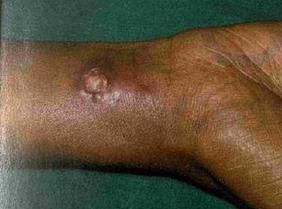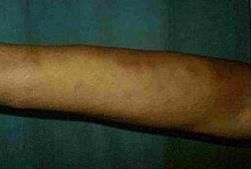Test: Hansen’s Disease - 2 - NEET PG MCQ
20 Questions MCQ Test - Test: Hansen’s Disease - 2
Treatment of severe ulnar neuritis in borderline tuberculoid leprosy is:
The Ridley-Jopling classification for leprosy is based on which of the following parameter:
A 27-year-old patient was diagnosed to have borderline leprosy and started on multibacillary multidrug therapy. Six weeks later, he developed pain in the nerves and redness and swelling of the skin lesion. The management of his illness should include all of the following except:
A patient of leprosy presents with painful ulcerated lesion on the wrist as shown. He has recently been started on MDT for leprosy. The DOC would.

Manifestation of ENL includes all of the following except:
A patient of leprosy presents with painful lesions on arms as shown. He is also febrile. He is given a drug which increases the numbness of the hands and feet. The likely drug is:

Which of the following is classical of borderline leprosy?
A single hypopigmented anesthetic patch on forearm with satellite lesion Likely diagnosis is:














